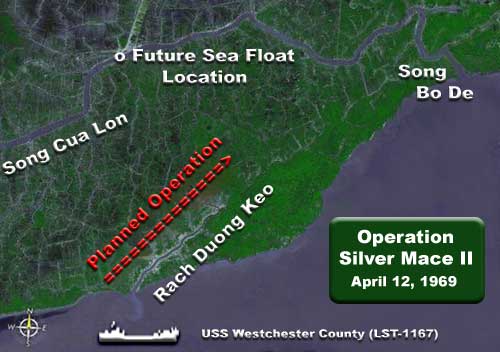
Operation Silver Mace II
April 12, 1969
Duong Keo River, Vietnam
 |
|
|
At about 1720 on 12 April 1969, thirteen Swift Boats of Coastal Division 11, Coastal Squadron One, entered the Rach Duong Keo,
formed up in a single in-line formation:
The last boat in the column, PCF 43, was a seasoned boat with an experienced crew. They also had a 10 man UDT Team on board with 1000 lbs of explosives plus gear. |
|
|
At cordinates WQ010500, the first five Swift Boats stopped and inserted their troops. The remaining eight (8) boats proceeded up the river to insert their troops at a point to be determined by the Vietnamese Company Commander and his American Advisor aboard PCF 31. |
|
At coordinates WQ045545, the column was taken under attack from the north bank with claymore mines, 75 mm recoiless rifles, B40 rockets, .51 caliber machine guns, rifle grenades and small arms fire.
The two lead boats, PCF 5 and PCF 21, were engulfed in fire and smoke from several claymore mines. In addition, PCF 21 was hit with a B40 rocket on the port quarter just below the main deck, and both of these craft were sprayed with small arms fire and automatic weapons fire. The after gunner on PCF 5 was seriously wounded, with one Vietnamese Marine killed and four other Marines seriously wounded. The next three boats - PCF's 31, 45 and 9 - were raked with small arms and multiple automatic weapons. This resulted in the forward machine gunners on both PCF 31 and PCF 45 being seriously wounded. However, both remained at their stations until clear of the ambush. One Vietnamese Marine on PCF 45 was also seriously wounded. PCF 51 was hit by two B40 rockets which blew out all of the main cabin windows. This boat was also rocked by small arms and automatic weapons fire. The after gun mount loader, QM3 Thomas Holloway, was killed in action due to a single bullet wound. One of the B40 rockets hit five inches above the waterline on the portside, causing the loss of one engine. PCF 51 was able to proceed on its single engine out of the ambush area, where the other engine overheated and became disabled. The 38 boat was also sprayed by small arms and heavy machine gun weapons fire. |
|
The last boat in line, PCF 43, was hit with a claymore mine, one 75 mm recoiless rifle round and three B40 rockets.This devastating series of hits caused mortal injuries to the Officer-in-Charge, LTJG Donald Droz. In addition, HMC Robert Worthington of UDT Team 13 riding on this boat, was also killed in action. Two of the other UDT 13 team members on board were seriously wounded in this initial burst of enemy fire.
|
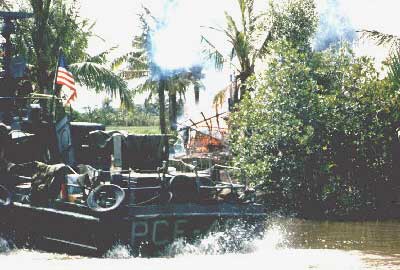 Image courtesy of Ken Turgeon |
The Officer-in-Charge of PCF 38 observed this action, and turned back into the area to assist. As a result, the boat received two B40 rockets in the pilot house and cabin areas, which seriously wounded the OinC. These hits also jammed the pilot house steering system, with the rudder hard over left, and incapacitated the port engine. Despite serious wounds to his left leg and loss of hearing from the blast, the OinC immediately regained control of the boat from the after steering station. Through his expert seamanship, PCF 38 was able to move outside the ambush area while suppressing enemy machine gun and small arms fire with its own weapons. |

Image courtesy of the Texas Tech Vietnam Archives |
Meanwhile, the remaining damaged six boats (5, 21, 31, 45, 9 and 51) sped out of the kill zone and the OTC had them beach upstream
from the ambush site in a clearing at cordinates WQ058558 to form a defensive perimeter. The OTC began seeking help in the form of
MEDEVAC assistance for the wounded from the supporting SEAWOLF helicopters.
|
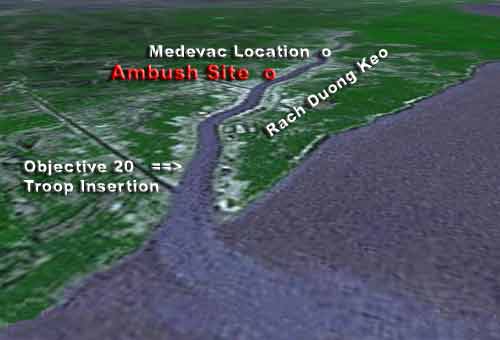
|
As soon as it was able to do so, PCF 38 informed the OTC, by radio, of PCF 43's dire circumstances. The SEAWOLF helicopters overhead, one with Captain Roy Hoffman - CTG 194.5 - on board, also observed that PCF-43 was in trouble and beached in a position down river from the other boats at the defensive location.
The OTC redirected the helicopters (SEAWOLF 14 and SEAWOLF 16) to provide covering fire for the disabled PCF 43. They proceeded to
do so, laying down a barage of M-60 machine gun fire and 2.75 inch rockets into the enemy postions to provide relief for the men on
the stricken Swift who had taken cover in the brush alongside their vessel and were returning fire with small arms, grenades and
M-60 machine guns at the hostile forces in bunkers on the river bank.
|
|
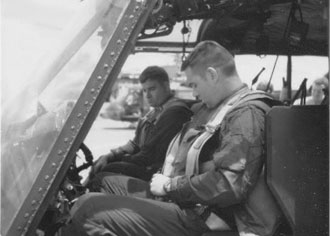
Lcdr Don Hartman and Ltjg Bill Wallen |
|
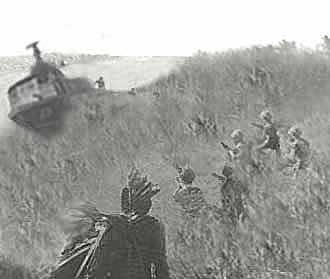
|
|
Even though five undamaged Swifts (103, 23, 67, 93 & 94) were proceeding up river from the first troop insetion location (Objective 20), the OTC made the decision to attempt the rescue of PCF 43's personnel using the only two available boats from the up river location: PCF 5 and PCF 31 (with the OTC on board). Both boats returned to the ambush location with the Seawolf close air support still overhead. |
|
PCF 5 attempted, unsuccesfully, to tow PCF 43 off the bank, while PCF 31 took aboard the men of the stricken Swift. Only three unharmed sailors were retreived from PCF 43. There were twelve seriously wounded men and the two KIA's. The bravery and skill of the crews of both PCF 5 and PCF 31 were directly responsible for saving the lives of the survivors. With the rescue and evacuation completed, PCF 31 and PCF 5 returned to the MEDEVAC perimeter, where the dazed survivors of PCF 43 joined the somber procession of the wounded sailors and Marines being ferried to dustoff helicopters. Everyone seemed to be trying bravely to collect their thoughts concerning the events of the past hour. |
|
The quick response, in the face of heavy enemy fire, by personnel in PCF 38, PCF 5, PCF 31, Seawolf 14 and Seawolf 16 was in the highest
tradition of the Naval Service.
P. A. Yost |

Image courtesy of Independent Lens |
|
Only twenty minutes after the surviving crew and UDT Team from PCF 43 had been evacuated, the vessel's fate was sealed. The over one thousand pounds of high explosives and mortar rounds stored on board concocted an eruption of cataclysmic intensity, hurling a spuming vortex of flame, smoke, and twisting metal over five hundred feet into the air. The Swift's twin diesels could not be halted during the fight and had overheated. This ignited the fuel leaking from the vessel's storage tanks and started an irrevocable chain of events which ended in the craft's ultimate demise.
|
|
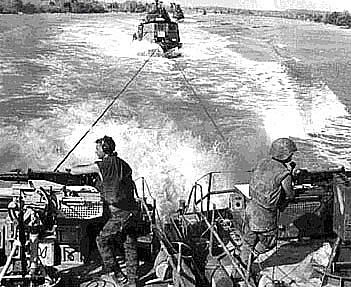
PCF 51 being towed out of the Duong Keo April 13, 1969 |
Despite the tragic loss of PCF 43 and so many of the complement of VN Marines and sailors in the Silver Mace II force, the operation to sweep the area around the Duong Keo area was continued the following day. By the end of April 13, however, the Swift Boats had exited the river, passing by the sad and blackened hulk that was once an intact Swift Boat. Whatever bravado that had existed before the start of the entrance into the river became a grim reality and determination to learn from the mistakes made. And to continue the job and fight on, accomplishing the mission another day. |
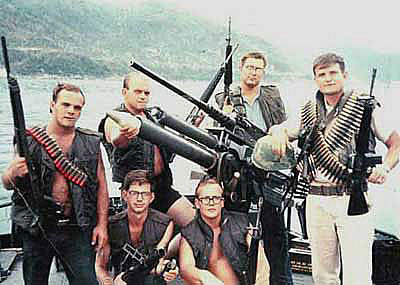
The crew of PCF 43 |
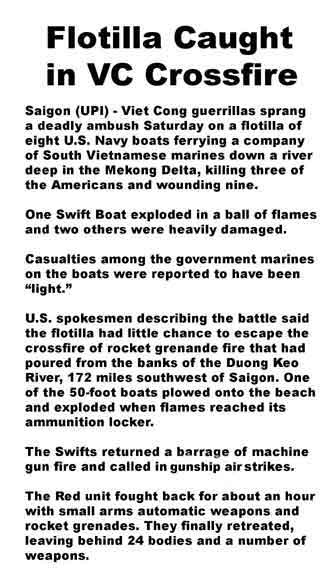 UPI Article on the battle |
Tracy Droz Tragos is the daughter of LTJG Donald Droz, who was fatally wounded while serving as Officer-in-Charge of PCF 43 during the operation/engagement described above. Now in her thirtys, she was only three months old when her father met his tragic death. During the year 2002, she embarked on a journey to know and finally grieve for the father she never had a chance to grow up with. As a film maker, she documented the steps she went through in this quest and released the result in 2003 as a wonderful documentry film entitled "Be Good, Smile Pretty" Do not miss the chance to see this film. It transcends any feelings you may have about the Vietnam conflict, and you will walk away with a warm, heartfelt feeling for all the sons and daughters and families that have been left behind by the tragedy of wars past and present. |
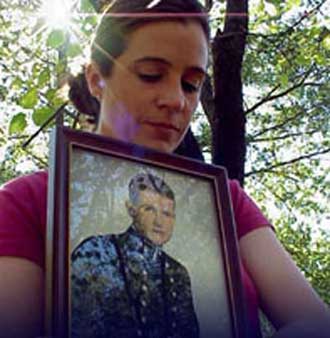 Thirty-two years later, one daughter's struggle to know and grieve for her father who died in Vietnam when she was three months old, becomes a journey of discovery, healing and remembrance. |
This web site is Copyright � 2002 by Robert B. Shirley. All rights reserved. Click on image to return to the homepage
|